#swordbilled hummingbird
Text
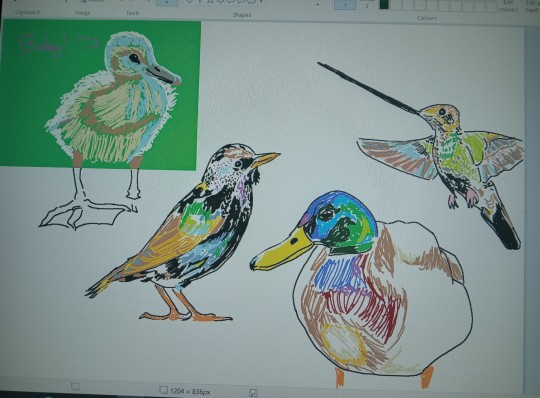
MS Paint birdies :)
(Copied from references on Google Images, none of the photos belonged to me)
#birds#swordbill hummingbird#european starling#mallard#cygnet#mute swan cygnet#starling#mallard duck#duck#ducks#hummingbird#hummingbirds#sword-billed hummingbird#swordbilled hummingbird#anas platyrhynchos#cygnus olor#sturnus vulgaris#ensifera ensifera#bird#bird art#ms paint
24 notes
·
View notes
Text

Sword-billed Hummingbird (Ensifera ensifera), male, family Trochilidae, order Apodiformes, Pichincha, Ecuador
The males of this bird have the greatest bill to body length ratio of any birds (being the only bird with a beak longer than the rest of its body).
photograph by Thomas Lebrun
732 notes
·
View notes
Text
Sword-billed Hummingbird (Ensifera ensifera)
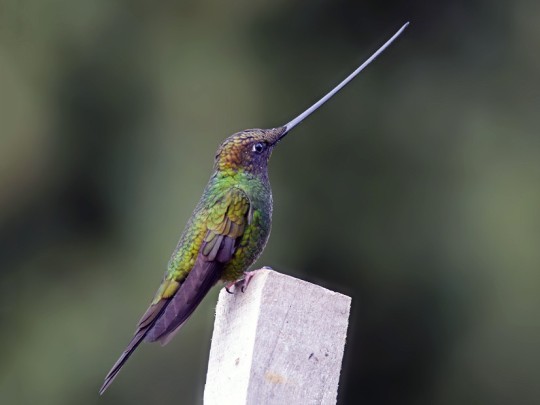

"Their beaks are longer than their bodies"
The genus and species name, ensifera, is derived from the Latin words ensis (sword) and ferre (to carry). The swordbill is the only species in its genus, too! These birds live along the Andes mountains, inhabitting humid montain forests and shrubland. They're a non-migratory species.
The swordbill's amazing bill length is most likely due to it co-evolving alongside a plant known as Passiflora mixta, which has a long, tubular corolla that nearly matches the length of the swordbill. The two overlap almost completely in range, and while other pollinators may exist for the plant, they have not been observed.
Sources:
Image Source: eBird ( Joshua Vandermeulen)
#in memoriam (joke)#Ensifera ensifera#sword-billed hummingbird#swordbill hummingbird#swordbill#trochilidae
83 notes
·
View notes
Text
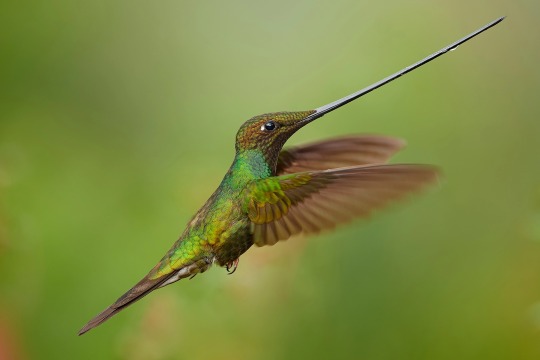
Man sometimes I think about how far dinosaurs have come and then I remember this guy. Just amazes me… evolution is so neat I will not get over it
This dude is a swordbill hummingbird btw!
165 notes
·
View notes
Text

Metallic Birds (part 1 / 2). Their environment is rich in metal and some plants and animals have adapted to use the metal they ingest. These birds can grow metallic feathers and horn-like structures.
Great Swordbill: Also known as a Knight Bird. A large bird that grows a sword-like horn on it's head. A large metal growth on the back of the skull acts as a counter-balance to the heavy horn. Both males and females have this horn, and it's used to forage food and crack open nuts. Males however have larger horns and use them to fend off other males during mating season. The feathers on their body contain metal filaments that curl and link together, forming a protective chain mail.
Glittering Fencer Hummingbird: This bird grows a thin, delicate horn from its head. Metal in the feathers and at the ends of long filaments glitter when they fly. Only males grow the horn, and it's to compete with other males. Certain flowers have adapted to allow the Fencer Hummingbirds easy access to the metal-rich pollen that grows inside. A slit along the top of the flowers let the birds feed without the horn getting in the way. Various species of these birds grow different metals from their body, including copper, gold, iron, etc.
Rusty Legcutter: These predatory birds grow metal tusks on either side of their beaks. Their quick runners, and they use their speed to catch large prey animals by surprise, then use their tusks to slice open their legs. Weakened, the prey are usually taken down by larger predator animals, after which the Legcutters gain access to the carcass. Legcutters have developed a habit of digging their tusks in damp dirt, which encourages rust growth. In turn, the rusty texture easily picks up dirt and bacteria. If the blood loss from the cuts don't weaken the prey, a tetanus infection will. Farmers who share land with Legcutters must wear metal-lined boots, and outfit their livestock with metal grieves, to protect themselves from the birds.
4 notes
·
View notes
Note
Top 5 bird species? (btw I love seeing your bird and Riddler fan art posts on my dash)
:)
Swordbill Hummingbird. It's a silly guy, with such a long beak, I love birdies that look so disproportionate
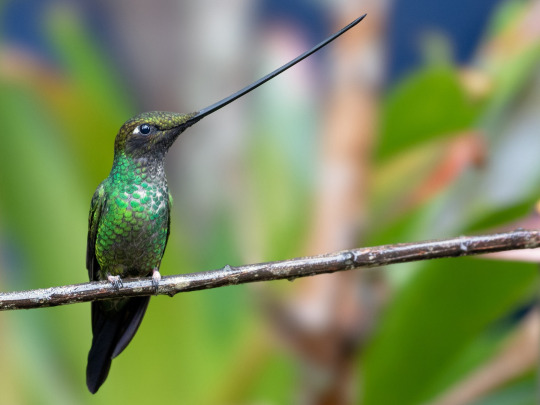
2. Common wood pigeon. They're a common guy, but they're like little friends, they're such cuties, and they like to come into my garden. There's a pigeon couple around my street and they cuddle on the rooftops and it's so adorable. They're the first bird call I could recognise with their "COO COOOOO COO! COO COO COO!"
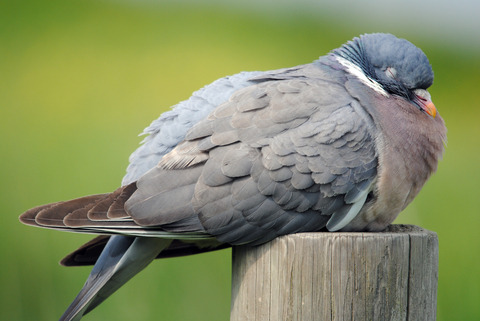
3. Moorhen. I've seen a couple of these, and their feet look so silly and big. Used to think they were coots. This is a baby and its feet are so so silly
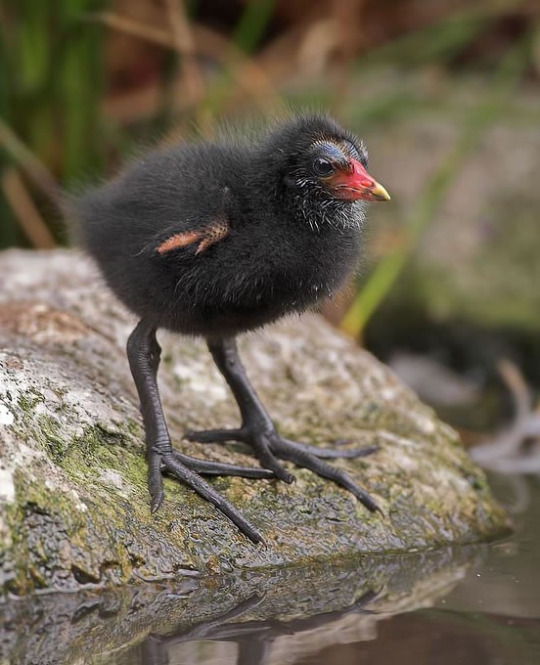
4. Emerald Starling. Riddler colours.

5. European Herring Gull. Aka seagulls. They're evil [affectionate]. I've seen one yawn and make a noise like a cat meowing. Now that I love birds I no longer fear them and they hold no power over me.

There are so many birds out there so I'm giving an honourable mention to Canada Geese (who aren't as evil as everyone says they are) and ducks because they're so cute. I love waterfowl
10 notes
·
View notes
Note

May I have a swordbill hummingbird? They're so silly and I love them

THE SWORDS ARE FIGHTINGGGG!!!!
#sorry this looks shitty idk why I had trouble with them#anyway THE SWORDS#love these fuckers#mod gf#asks
11 notes
·
View notes
Note
if you were able to keep as many birds as you wanted and like, all their habitats were perfect and maintained and the laws all allowed it and everything, how many birds would you have and what species??
wooooooooooo baby i wish i could upload pictures of all of them but there's a limit of 30 per post and that's nowhere near enough adfasfasdf. soooooo here's the official list of all of my favorite birds!
blue jay, eurasian jay, stellers jay, black collared jay, azure jay, northern cardinal, vermillion cardinal, desert cardinal, pileated woodpecker, great spotted woodpecker, red bellied woodpecker, eastern bluebird, mountain bluebird, gold finch, blue finch, scarlet finch, strawberry finch, rose finches, zebra finch, purple breasted sunbird, violet backed starling, blue vanga, blue dacnis, grandala, indigo bunting, lazuli bunting, rositas bunting, varied bunting, variegated fairy wren, splendid fairy wren, superb fairy wren, white winged fairy wren, philippine fairy bluebird, asian fairy bluebird, taiwan blue magpie, himalayan monal, tui, ravens, crows, blue crowned pigeon, victorian crowned pigeon, american robin, pink robin, lilac-breasted roller, european roller, indian roller, flying roller, blue-bellied roller, malachite kingfisher, woodlands kingfisher, azure kingfisher, rose-crested fruit dove, superb fruit dove, dracula parrot, hyacinth macaw, blue bird of paradise, anna's hummingbird, swordbilled hummingbird, swallowtailed hummingbird, fiery-throated hummingbird, lesser violetear, crowned woodnymph, blue chinned sapphire, mute swan, black swan, black-necked swan, bohemian waxwing, spangled cotinga, banded cotinga, brazilian tanager, australian diamond firetail, flame bowerbird, asian golden weaver, golden pheasant, malayan peacock pheasant, south philippine dwarf kingfisher, guineafowl, green junglefowl, blue-grey tanager, malachite sunbird, great sapphirewing, ruby-topaz hummingbird, fiery topaz, crimson topaz, rainbow bearded thornbill, violet sabrewing, long-tailed sylph, red-tailed comet, variable sunbird, helmeted woodpecker, red-crested cardinal, blue-winged mountain tanager, cinnamon hummingbird, antillean crested hummingbird, violet capped woodnymph, sparkling violetear, blue pitta, mandarin duck
7 notes
·
View notes
Photo

The title of the bird with the longest beak, relative to body size, goes to the very aptly named swordbilled hummingbird.
This bird’s amazing beak, which can reach lengths of about 12cm, is longer than its body, allowing it to access nectar from the longest, thinnest blooms that other hummingbird beaks can’t reach
It is the only bird whose beak is longer than the rest of the body (excluding the tail).
Swordbilled hummingbirds live in the the Andean region of South America at altitudes of around 1,700–3,500m and is one of the largest species of hummingbird (there are at least 250 different species of hummingbird)
3 notes
·
View notes
Text



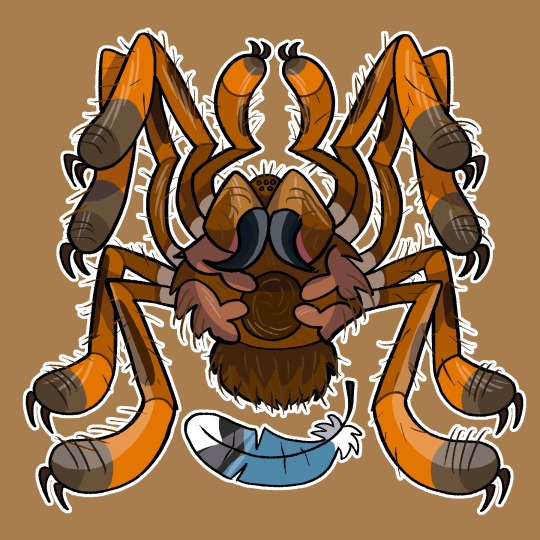






Friday afternoon Funkin? Haha!
Todays Funky Babies are:
Solenodon
Wombat
Komodo Dragon
Goliath Bird-Eater Tarantula
Paraya
Vampire Bat
Przewalski's Horse
Irrawaddy Dolphin
Swordbill Hummingbird
Sarcastic Fringehead
16 notes
·
View notes
Text
Duplicate Submissions
Alright, here is the list of duplicate birds that were submitted to this poll:
American Robin, Canada Goose, Dovekie, Eurasian Jay, Hoatzin, Blue-bellied Roller, Smew, Hoopoe, Dark-eyed Junco, Painted Bunting, Spoon-billed Sandpiper, Rifleman (Titipoumano), Archeopterix, Hooded Crow, Roseate Spoonbill, Northern Lapwing, European Starling, Steller's Jay, Great Auk, Eclectus Parrot, Ruby-crowned Kinglet, Spotted Towhee, Resplendent Quetzal, Vermilion Flycatcher, Kaua'i O'o, Ivory-billed Woodpecker, Hooded Pitohui, Rainbow Bee-eater, Long-tailed Tit (Shima Enaga), Sunbittern, Varied Thrush, Pied Currawong, Rock Pigeon, Domestic Chicken, Northern Gannet, Diederik Cuckoo, Yellow-headed Picathartes, Temminck's Tragopan, Greater Lophorina, Parotia, Grey Butcherbird, Green Jay, Horned Screamer, Magnificent Frigatebird, Spinifex Pigeon, Gorgeted Puffleg, Zebra Dove, Common House Martin, Swordbill Hummingbird, Greater Roadrunner, Rufous-crested Coquette, Wallcreeper, Racket-tailed Roller, Himalayan Monal, Crested Pigeon, Inaccessible Island Rail, Brown Creeper, Tufted Titmouse, White Wagtail, Bobolink, Shoebill Stork, Australian Brushturkey, black-throated magpie-jay, Greater Blue-eared Starling, spangled cotinga
This list will continue to be updated, but I'm not going to pin it to the top since technically these guys are not the focus of the poll (I just think they're neat :3). The tag placed on pics of these birds is ELIMINATED, as someone asked about tagging them and I figured out how to use the Mass Post Editor >:3
69 notes
·
View notes
Photo


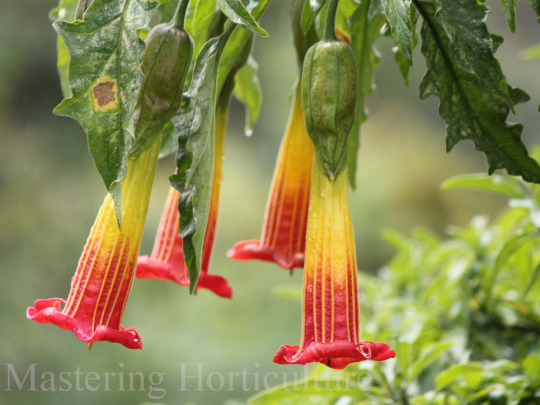

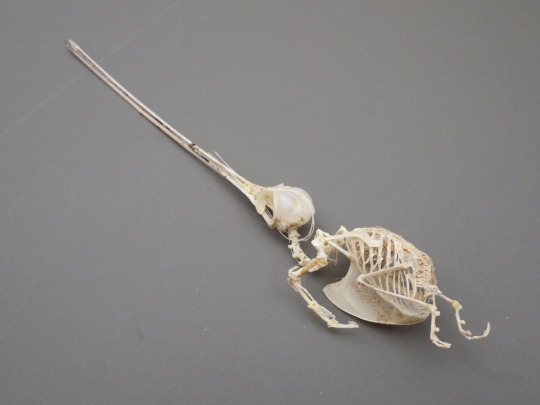

Slater Museum: Featured Creature - 25 Jan 2013
Sword-billed Hummingbird (Ensifera ensifera)
This week's creature was the skeleton of a Sword-billed Hummingbird (Ensifera ensifera), a species endemic to the Andes of South America (mostly above 2500 m elevation). Ensifera, which means "sword-wielder," is the only species of bird on the planet with a bill longer than its body. This remarkable bill is highly adapted to feed on flowers with very long corollas, such as Brugmansia (shown above), Passiflora, Datura, and Fuchsia.
With such an astonishingly large bill, this hummingbird must also possess a tongue of equally immense length. And in fact, Ensifera has one of the longest tongues of any bird in the world! It acts much like the tongue of a woodpecker, darting out beyond the bill to slurp up tasty nectar, and wrapping around the back of the skull when not in use. You can see it's long, thread-like tongue (hyoid) bones in the skeletal images above. Notice that the base of the hyoid bones wrap around the skull and insert at the nostrils, while the opposite ends can be seen protruding above the base of bill.
You can imagine that possessing such a large bill would present this hummingbird with a multitude of problems. For example, preening is an essential part of every bird's life and most birds preen with their bills. On average, a typical bird preens for 6 to 8 hours each day! This helps keep feathers clean and in tip-top shape for the difficult task of flying. Of course, this becomes a huge problem for Ensifera, because its bill is far too long to preen any of its dainty feathers. So instead, Sword-billed Hummers preen their entire bodies using only their feet! As such, Ensifera has the longest legs of the hummingbird family!
Super long bill, mega long tongue, extra long legs - this critter is unbelievable! Thank you, evolution.
#Ensifera ensifera#swordbilled hummingbird#birds#hummingbirds#skeleton#featured creature#slater museum#evolution at its finest#evolution#BEST JOB EVER!!!#my work#photography#Robert Niese
707 notes
·
View notes